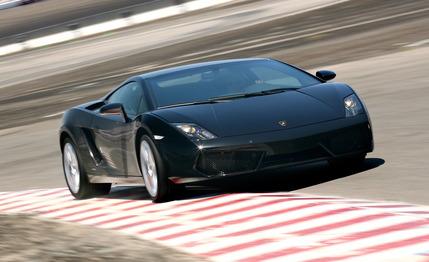 First Drive Review
First Drive Review
Hugging the outside wall of the banking at Las Vegas Motor Speedway at about 130 miles per hour, we had a thought: “This dash-top stitching looks perfect.”
Yes, the fencing was whizzing by in a blur, along with banner ads for cigarettes and motor oil and car wax and other assorted stuff. We were coming up fast on the braking cones that would prepare us for our slow, second-gear, 170-degree left-hander leading into the infield road-course portion of our track drive of the 2009 Lamborghini Gallardo LP560-4, and we’re focusing on dash stitching?
Well, it is really nice. But we wouldn’t have noticed it—at least not right then—if the new Gallardo weren’t so calm, so collected, and so composed at that speed. Indeed, it was only at about 120 mph that we even started hearing any wind noise. This is a car that lives for triple-digit speeds.
A Really Good Car—No Bull
Lamborghinis have always been rare, fast, and exciting. But they haven’t always been good cars. The new Gallardo LP560-4—and, to a large extent, its acronym-free Gallardo predecessor— is a very good car, however, pretty much any way you slice it. Well built, well equipped, and generally reliable, the Gallardo is a car one can actually drive each and every day.
The Gallardo has been given a thorough refresh for 2009. And we should make one thing clear right now: This is more than a nose job. It has more power, a better interior, and a more cohesive design. It also has a new suffix—LP560-4—to reflect its engine layout ( longitudinale posteriore , meaning the longitudinally mounted engine sits behind the driver), power output (560 PS, which equals 552 horsepower), and the number of drive wheels (four).
This Car Is Gonna Be on Tons of Bedroom Walls
The new car’s styling is at once more aggressive and more elegant than before. The front end has been given a bit more of a chin in the form of revised, enlarged cooling intakes. The headlamps have been trimmed and no longer take up a majority of the front fenders. Parent company Audi’s signature can be found in the fitment of LED daytime running lights, which are Y-shaped, perhaps to tie into the taillamps, which now recall those of the Murciélago with their asterisk-like directional light pattern.
The body sides and the rear decklid have also been smoothed and filled, with single slits replacing the dozens of gills on the original Gallardo. The skinnier taillights no longer wrap up onto the decklid, and they now sit atop a wide band of grillwork that visually widens the rear end for that extra-exotic look. Taking a page from Ferrari’s time-hewn handbook, Lambo fitted the decklid with a new plexiglass “window” to show drooling bystanders what’s underneath.
More Power, More Torque, More Fun
What’s under the window sure isn’t the same thing as before. The Gallardo’s naturally aspirated V-10 has been bored to 5.2 liters (up from 5.0) and fitted with a direct-injection system, enabling a high, nosebleed-inducing compression ratio of 12.5:1, resulting in a significant spike in output to 552 horsepower at 8000 rpm (from 512) and 398 pound-feet of torque (from 376). Lamborghini stresses that this is not the same V-10 found in certain Audi models (such as the RS6 wagon), stating that it has a unique block and heads, as well as its own direct-injection system co-developed with Bosch.